Martha Ullman West, Art Scatter’s chief international dance correspondent, took in “La Danse,” Frederick Wiseman’s documentary film about the legendary Paris Opera Ballet. How does it go wrong? Let her count the ways:

Last night I took a friend to Cinema 21 to see a benefit screening of La Danse, documentary filmmaker Frederick Wiseman’s take on the Paris Opera Ballet. Before I scatter a little venom about this highly uneven film, I would like to express my profound gratitude to Cinema 21 for supporting Oregon Ballet Theatre, the beneficiary of the screening.
Wiseman likes to be a fly on the wall with a camera (conjuring interesting visions of Vincent Price, come to think of it) at various kinds of institutions, from high schools to juvenile courts. And he’s no stranger to ballet: In 1993 he did a similar film on American Ballet Theatre, Ballet.
 That one was OK, but just OK, though I quite loved the scene of then artistic director Jane Hermann losing her temper on the phone with the Lincoln Center administration, using language she did not learn at tea in the James Room at Barnard College.
That one was OK, but just OK, though I quite loved the scene of then artistic director Jane Hermann losing her temper on the phone with the Lincoln Center administration, using language she did not learn at tea in the James Room at Barnard College.
La Danse isn’t quite the worst dance film I’ve ever seen — Robert Altman’s The Company, not quite a documentary but not quite a feature film either, is probably worse.
But what these two directors seem to me to share is really lousy taste in choreography.
In The Company, which is about the Joffrey Ballet, all the revelations of the inner workings of the company culminate in a performance of the ghastly The Blue Snake, choreographed by Robert Desrosiers.
In La Danse, we see a lot of rehearsals and a pretty lengthy slice of performance of Angelin Preljocaj’s Medea, which culminates in the murder of her two children and the gorgeous ballerina Delphine Moussin covered in fake blood. There are literally buckets of the stuff on the stage, and post-infanticide, she carries a large piece of red fabric in her mouth.
Scatterers who are familiar with Martha Graham’s Cave of the Heart, which has no fake blood on a stage defined by Isamu Noguchi’s extraordinary set pieces and props, surely will feel as outraged as I was by this cheap knock-off.
In Graham’s masterpiece, Medea seems to pull out her own guts, which are represented by a red velvet rope: It’s a brilliant piece of theater that makes me shudder every time I see it. Preljocaj’s buckets of blood would have given me the giggles if I hadn’t remembered Melina Mercouri laughing her way through a performance of Medea in Jules Dassin’s movie Never On Sunday.
The rehearsals recorded in La Danse are quite interesting, especially when Preljocaj, having set the ballet, tells Moussin that it is now up to her, giving her a good deal of freedom to interpret the role.
Moussin is hardly the only perfectly gorgeous dancer we see in the film. All the dancers he films are lovely to look at, with extraordinary technique, and he shows them working in studios with raked floors, high up in the Palais Garnier, the arched windows overlooking the Paris rooftops. (Those shots, as well as exterior shots from the roof of the building, made me want to jump on the next plane to Paris).
We see them taking a break, eating in their own cafeteria (in which the food looks neither healthy nor like haute cuisine), getting on the elevator, walking down long corridors, being made up.
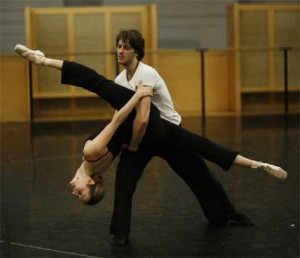 We also see them being coached by long-retired dancers, in one session a man and a woman (unidentified; typical Wiseman) arguing with each other about whether a leg should be raised or lowered. It’s all very amusing and quite lovable, like the old dancers in that most excellent of ballet films, Ballets Russes, by Dayna Goldfine and Dan Geller.
We also see them being coached by long-retired dancers, in one session a man and a woman (unidentified; typical Wiseman) arguing with each other about whether a leg should be raised or lowered. It’s all very amusing and quite lovable, like the old dancers in that most excellent of ballet films, Ballets Russes, by Dayna Goldfine and Dan Geller.
But that seems to be Wiseman’s only real bow to tradition. He completely omits the Paris Opera Ballet School, which is where those poor murdered children in Medea, forced to huddle with buckets over their heads, came from. For a good look at the ethos of the Paris Opera Ballet, and how students rise from the ranks, through a fixed hierarchy, there is an old, black-and-white French film called in English Ballerina that tells you a lot more about it than La Danse.
In a piece of directorial self-indulgence that makes this 158-minute film much, much too long, you do become extremely familiar with the corridors of the upper floors and the subterranean passages of the Palais Garnier. I did quite like the fish who, in the words of a colleague, had set up housekeeping in a flooded passage, and the metaphor of the beekeeper on the roof of the building was not lost on me: With providers of food, costumiers, set builders, accompanists, janitors, cleaners, ballet masters and Brigitte LeFevre, the queen bee who is the artistic director of the company, the building is indeed a hive of activity.
And it was a pleasure, a profound pleasure, to see these dancers performing some bits of Paquita in the grand tradition — and what a contrast to the rehearsals of Rudolf Nureyev’s unspeakable staging of The Nutcracker, which would appear to be completely free of children.
Wiseman does know how to film dancers: He isn’t obsessed with their feet, and he does show the whole body. On the other hand, a lot of the time, in the studio, he filmed them from the back so we saw their reflections in the mirrors — somewhat distorted, at that.
In the end, La Danse provides a pretty distorted view of a company that is one of the best in the world, and that’s a pity. It deserves better, and so do we.
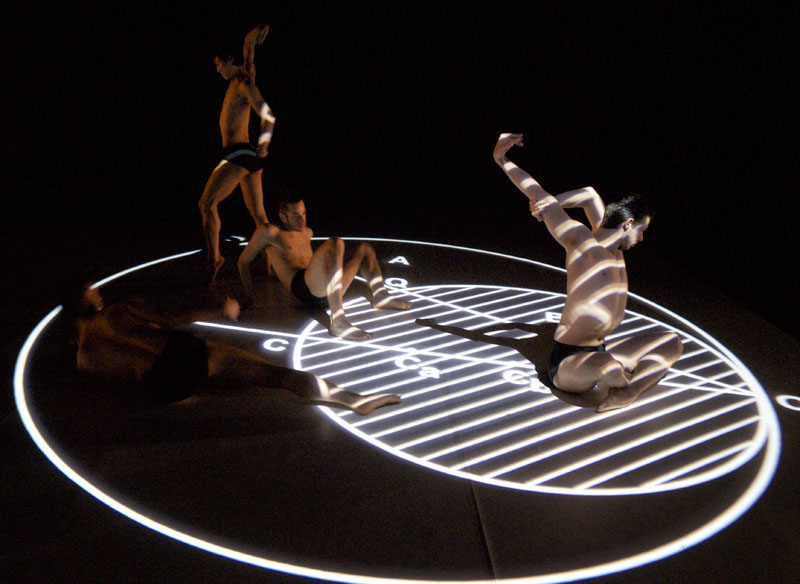
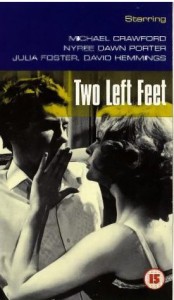 Watching dance, on the other hand, is a longtime pleasure, one that slides from tap to tango, classic to contemporary, Broadway to ballet. And it strikes Mr. Scatter that, while a lot of people weren’t looking, Portland’s become a heck of a dance town.
Watching dance, on the other hand, is a longtime pleasure, one that slides from tap to tango, classic to contemporary, Broadway to ballet. And it strikes Mr. Scatter that, while a lot of people weren’t looking, Portland’s become a heck of a dance town.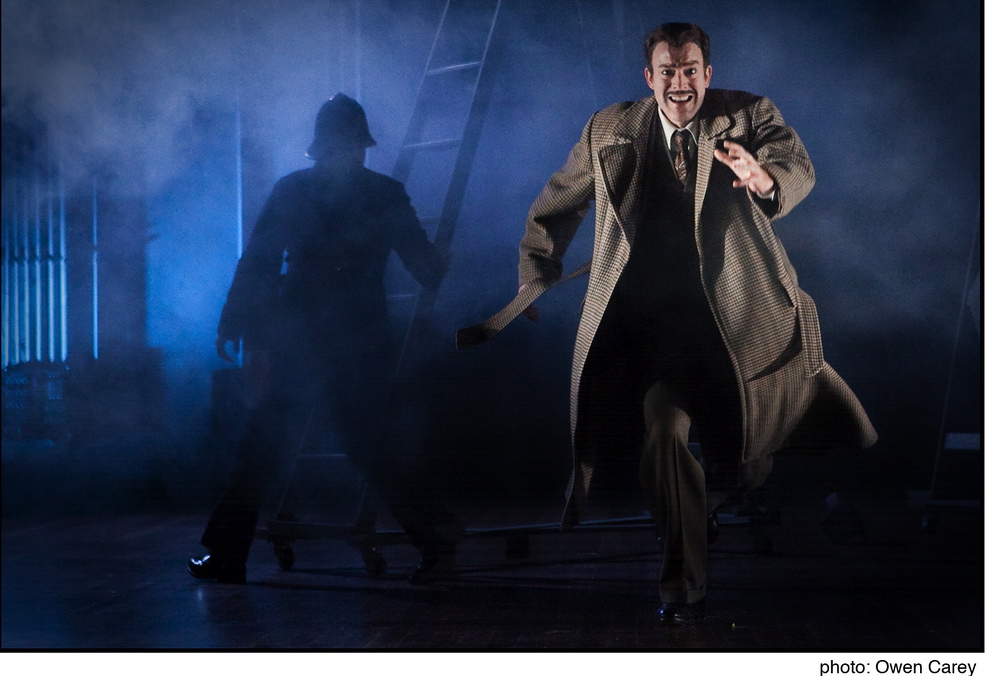
 Then, at midday Friday, the Scatter duo showed up at the Gerding Theater in the Armory to see dancer Linda Austin and her cohort J.P. Jenkins tear up the joint with a fascinating visual, musical and movement response to Mark Applebaum‘s elegant series of notational panels, The Metaphysics of Notation, which has been ringing the mezzanine railings above the Gerding lobby for the past month. Every Friday at noon someone has been interpreting this extremely open-ended score, and this was the final exploration. California composer Applebaum will be one of the featured artists this Friday at the Hollywood Theatre in the latest concert by
Then, at midday Friday, the Scatter duo showed up at the Gerding Theater in the Armory to see dancer Linda Austin and her cohort J.P. Jenkins tear up the joint with a fascinating visual, musical and movement response to Mark Applebaum‘s elegant series of notational panels, The Metaphysics of Notation, which has been ringing the mezzanine railings above the Gerding lobby for the past month. Every Friday at noon someone has been interpreting this extremely open-ended score, and this was the final exploration. California composer Applebaum will be one of the featured artists this Friday at the Hollywood Theatre in the latest concert by 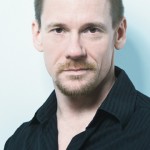 For the next two Sunday afternoons he’ll be ambling over to the
For the next two Sunday afternoons he’ll be ambling over to the 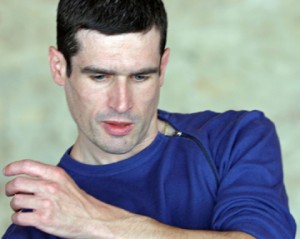 Next Sunday, March 7, the guest will be the Paris-based Italian choreographer Luca Veggetti (photo at right), whose career has roamed from
Next Sunday, March 7, the guest will be the Paris-based Italian choreographer Luca Veggetti (photo at right), whose career has roamed from 
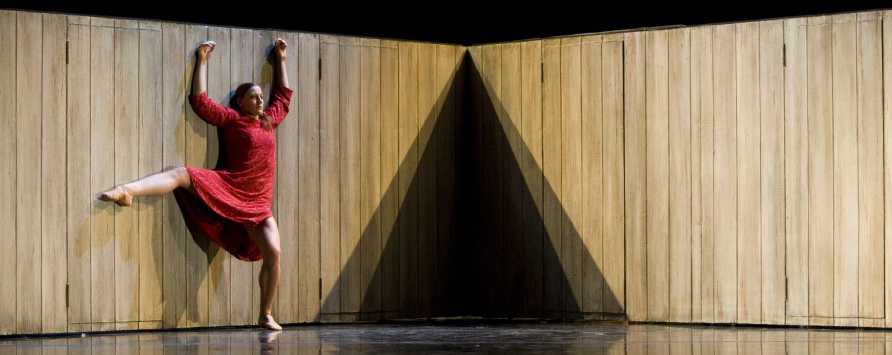
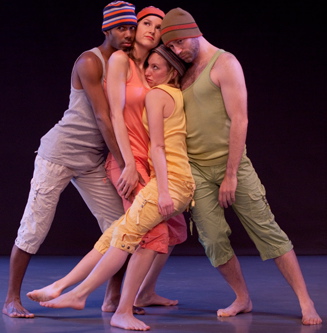
 So it’s something of a revelation to see some of these works performed by other bodies. Thursday’s performance included 10 short dances, plus a couple of Mitchell Rose’s terrific short comic films — a smorgasbord of BodyVox hits. Seeing fresh bodies perform them wasn’t just about getting to know a new crop of good dancers in town. It was also about rethinking these works as pieces of choreography that both define the BodyVox style and stand on their own as discrete works of art that have entered the contemporary-dance repertoire.
So it’s something of a revelation to see some of these works performed by other bodies. Thursday’s performance included 10 short dances, plus a couple of Mitchell Rose’s terrific short comic films — a smorgasbord of BodyVox hits. Seeing fresh bodies perform them wasn’t just about getting to know a new crop of good dancers in town. It was also about rethinking these works as pieces of choreography that both define the BodyVox style and stand on their own as discrete works of art that have entered the contemporary-dance repertoire.
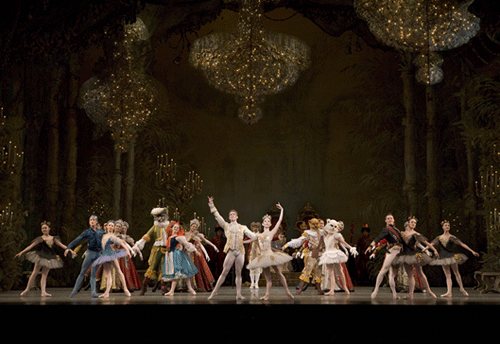
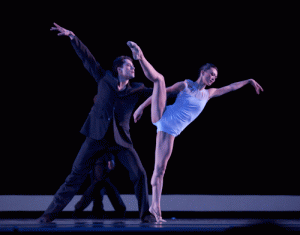 The Rose Adagio, for those who have never seen Beauty, takes place at Princess Aurora’s birthday ball in the ballet’s first act, when she dances, briefly, with four suitors, portrayed Thursday night by Lucas Threefoot, Brian Simcoe, Christian Squires and Brennan Boyer, who were dressed in ordinary practice clothes, as was Iino.
The Rose Adagio, for those who have never seen Beauty, takes place at Princess Aurora’s birthday ball in the ballet’s first act, when she dances, briefly, with four suitors, portrayed Thursday night by Lucas Threefoot, Brian Simcoe, Christian Squires and Brennan Boyer, who were dressed in ordinary practice clothes, as was Iino.
 That one was OK, but just OK, though I quite loved the scene of then artistic director Jane Hermann losing her temper on the phone with the Lincoln Center administration, using language she did not learn at tea in the James Room at Barnard College.
That one was OK, but just OK, though I quite loved the scene of then artistic director Jane Hermann losing her temper on the phone with the Lincoln Center administration, using language she did not learn at tea in the James Room at Barnard College. We also see them being coached by long-retired dancers, in one session a man and a woman (unidentified; typical Wiseman) arguing with each other about whether a leg should be raised or lowered. It’s all very amusing and quite lovable, like the old dancers in that most excellent of ballet films, Ballets Russes, by Dayna Goldfine and Dan Geller.
We also see them being coached by long-retired dancers, in one session a man and a woman (unidentified; typical Wiseman) arguing with each other about whether a leg should be raised or lowered. It’s all very amusing and quite lovable, like the old dancers in that most excellent of ballet films, Ballets Russes, by Dayna Goldfine and Dan Geller.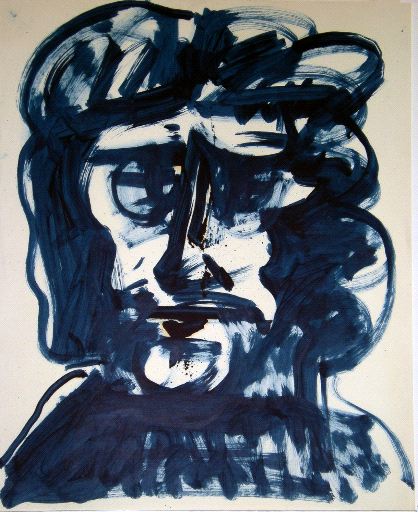
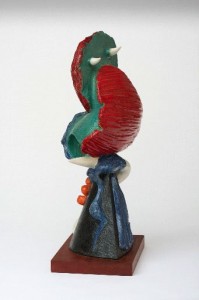 Impossible to even think about that now, which must mean Portland’s evolving into a city at last.
Impossible to even think about that now, which must mean Portland’s evolving into a city at last. Another big player in those midcentury years, sculptor and printmaker Manuel Izquierdo, died in July. Notable (like so many of his contemporaries) as a teacher as well as an artist, he was also one of the artists who connected the Northwest’s sometimes insular scene to international ideas. He was born in Madrid, left Spain during the Civil War, and spent most of his adult life in Portland. But he brought a European spirit with him.
Another big player in those midcentury years, sculptor and printmaker Manuel Izquierdo, died in July. Notable (like so many of his contemporaries) as a teacher as well as an artist, he was also one of the artists who connected the Northwest’s sometimes insular scene to international ideas. He was born in Madrid, left Spain during the Civil War, and spent most of his adult life in Portland. But he brought a European spirit with him.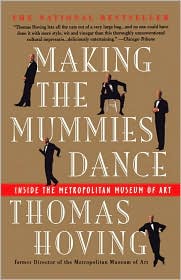 Hoving was a swashbuckler, a showman, a democratizer, maybe even something of a pirate. When he took over the great Metropolitan Museum of Art in Manhattan in 1967, at the age of 35, he declared it moribund and set out to make it the most popular show in town.
Hoving was a swashbuckler, a showman, a democratizer, maybe even something of a pirate. When he took over the great Metropolitan Museum of Art in Manhattan in 1967, at the age of 35, he declared it moribund and set out to make it the most popular show in town.